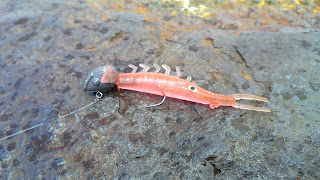 |
| The name 'Pouting' was already taken |
En route, as the car was buffeted by side winds and various showers, I had the idea to go a little bit further and checked out weather, tides etc at St Abb's Head. All looked as conducive to a good day as anywhere and my decision was made.
 |
| Stayed still just about long enough to be pictured |
I decided to explore the rock pools. There were plenty but mostly quite shallow or containing too much weed. Nothing showed an interest, indeed, I only saw fish in one rock pool, possibly small gobies or blennies which scattered as I approached.
 |
| A nicer part of the day |
Back round at the main harbour entrance I bashed on with some light pink Isome on a jighead. I'd noted the layout of the bottom when the tide was low and was now able to bounce the Isome around on the bottom avoiding snags. Before too long, and reasonably unexpectedly I felt a fish take and tightened into something with a bit of potential. While there was some distance and a flowing tide between me and the fish, it gave an excellent account of itself, staying low until I was able to raise it enough to ID it as a Coalfish. The 20ft or so lift from the water to the harbour wall went without a hitch and my day was under way. Measuring 14 inches, and weighing about a pound and a half this was also a new PB.
 |
| Slayer of the last four fish |
As things were going well, I decided to alter my tactics a little. I've had a wee shrimpy thing in my bag for ages which I think I found somewhere and decided to give it a go. Almost immediately I was into fish 4, a little under 14 inches and then fish 5, the baby so far at just 13.5 inches. Although I didn't know at the time, the minimum taking size for Coalies is 14 inches. I reckoned they were just too small to take (guessing 16+) and they all went back to get bigger.
 |
| During one of the rain showers |
Very little to report though, on arrival it was very windy. Fishing alone on the end of a windy pier had me thinking of Darwin awards and so I returned to the car and back up the coast to St Abb's and the same spot at the harbour mouth.
Very quickly I connected with another couple of Coalfish, much the same as before, the final one reaching 14.5 inches and raising my recent PB half an inch. Fish 8 was on after that, but for the first time of the day, it came off. Very likely to be another Coalie as the fight was similar, tugging, running and staying low, certainly pretending in the water to be a bigger fish than I suspected. After this, things went quiet and a while later pretty much on high tide, I decided to pack it in.
On the road home I passed Torness. Knowing the tide timing wasn't perfect, I thought it was still worth a try. But a quick half hour or so didn't produce anything and it was time to finish up for good.








